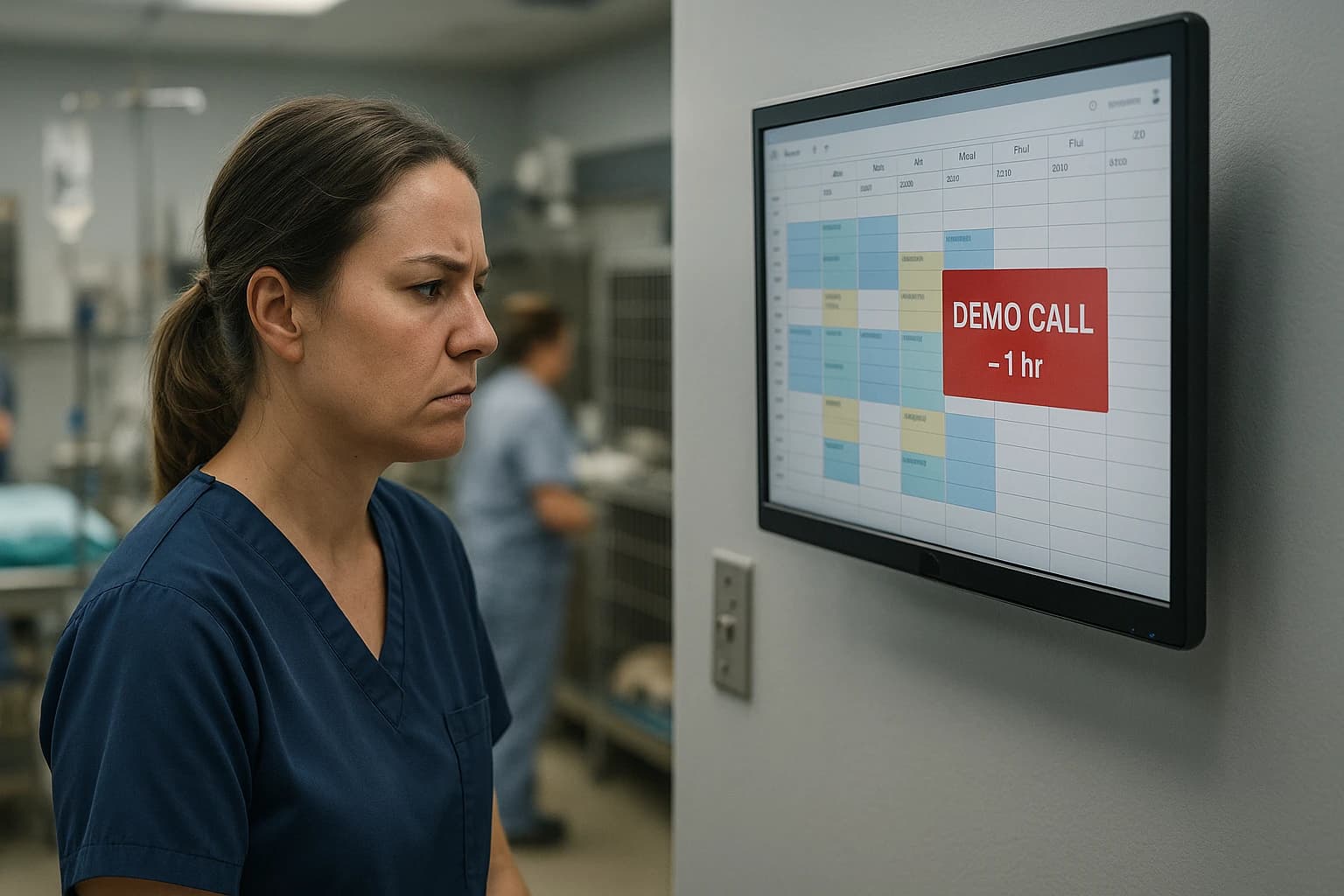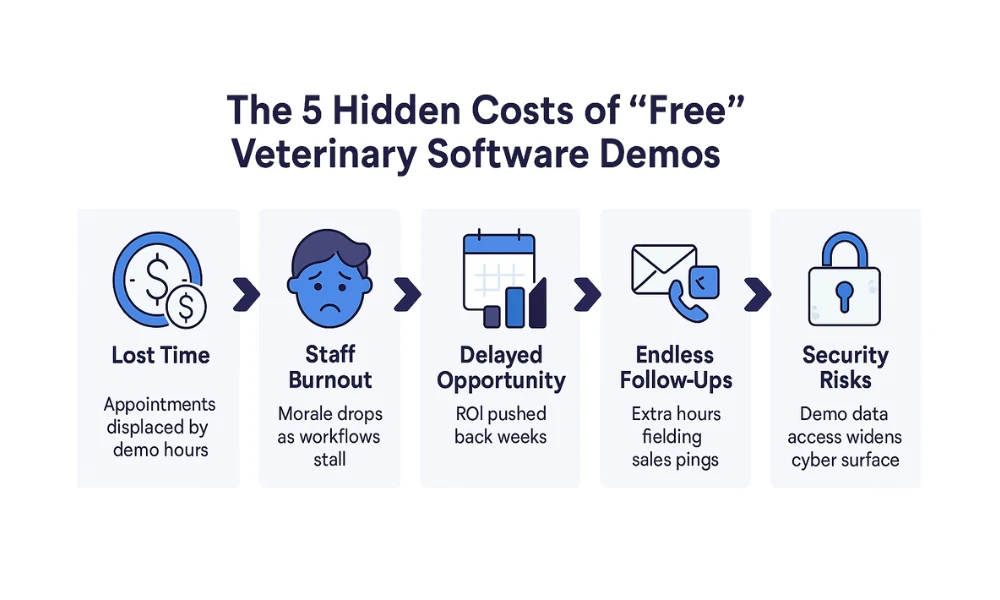The Hidden Costs of ‘Free’ Veterinary Software Demos
Free veterinary software demos drain time, staff morale, and profits. Discover five hidden costs and smarter ways to choose tech without the demo tax.

“Sure, we can give you a free demo, just pick a time that works for your whole team.”
Every veterinary professional has heard that line. But what exactly does that "free" demo really cost your hospital?
Why “Free” Often Means Expensive
The psychology of sunk time
Vendors know that if they can persuade you to block off thirty minutes or an hour, or even worse, an afternoon, for a demo, you’re more likely to feel committed to seeing the purchase through. That’s the sunk‑cost fallacy at work, and it stacks the deck in favor of the salesperson, not the clinician.
The power imbalance
Sales reps conduct demos every day; your team might evaluate software only once every few years. That mismatch means the vendor controls the pace, scope, and narrative. The longer the demo, the more control they gain, and the less objective your evaluation becomes.

Hidden Cost #1: Lost Clinical Hours
A typical small‑animal hospital books 4–8 appointments per veterinarian each hour. When you pull even two DVMs plus a technician out of rotation for a 60‑minute demo, you’re sacrificing 8–16 consultations, often worth $1,500–$3,000 in revenue.
Multiply that by the two or three demos most practices attend, and you’ve burned a week’s worth of profit that could have funded new equipment or staff continuing education.
Pro tip: Add up the average production value of each participant before you accept a demo invite. Seeing the figure in black and white makes it easier to protect your calendar.
Hidden Cost #2: Staff Burnout and Morale
Veterinary teams already juggle phones, curbside consults, prescription refills, and emotionally intense client conversations. Forcing them into a midday screen‑share can feel like salt in a wound.
- Cognitive overload: Switching from hands‑on patient care to user‑interface critique is mentally exhausting.
- Workflow disruption: Backlogs form the moment you pull techs off the floor.
- Perceived futility: If staff suspect leadership has already chosen a platform, the demo becomes performative and erodes trust.
Burned‑out staff are 3× more likely to resist new technology, even if it would ultimately lighten their load.
Hidden Cost #3: Opportunity Cost of Delayed Decisions
Every extra week spent scheduling and attending demos pushes back go‑live, which in turn postpones the benefits you want: faster check‑ins, automated reminders, or smoother inventory management.
Consider two clinics:
| Scenario | Timeline to Decision | Hours Save Per Week (post-implementation) | Annual Value* |
| Fast Track (no demos) | 3 weeks | 5 | $26,000 |
| Demo-Heavy | 10 weeks | 5 | $19,000 |
*Assumes $100/hour blended staff cost
Those seven extra weeks cost the demo‑heavy practice $7,000 in unrealized efficiency alone.
Hidden Cost #4: Biased Information & Endless Follow‑Ups
Demos are marketing theatre. Reps lead with glossy features and swerve around shortcomings. Post‑demo, the drip campaign begins: emails, calls, and “just checking in” texts that siphon more minutes from your day.
Even if you ultimately pass on the product, you’ll spend weeks deleting follow‑ups or rehearsing polite refusals. Time is money and sanity.
Hidden Cost #5: Data Security & Privacy Risks
Many demo environments are shared sandboxes loaded with fake cases. But some vendors request partial access to your real PIMs so they can “show live data.” Every credential you hand over widens your attack surface.
Without a signed Business Associate Agreement (BAA) or SOC 2 audit, you risk violating state data‑privacy rules and eroding client trust.
How to Evaluate Software Without the Demo Tax
1. Define must‑have workflows first
Before you ever visit a vendor page, gather your team and list the three workflows that absolutely must improve (e.g., digital forms, two‑way texting, inventory counts). Attach a metric like seconds saved, clicks reduced, etc for each.
2. Use structured scorecards
Download our Vendor Scorecard Template (see link at bottom) and assign weightings (1–5) to functional areas, price transparency, support, and integration readiness.
3. Leverage peer reviews & co‑view analytics
Peer feedback provides real‑world context demos can’t. Upcoming features on VetSoftwareHub will allow you to sort reviews by hospital size, species focus, or region. Our upcoming co‑view algorithm highlights products veterinarians frequently research together, so you can spot true alternatives without attending three webinars.
4. Run a self‑guided sandbox
Many vendors offer trial logins ... ask for one. Give access to a single "champion" on your team who records Loom videos of critical tasks. Share those clips in Slack or your team communication tool so everyone can watch asynchronously.
5. Negotiate a micro‑pilot, not a demo marathon
A 30 day, contract‑free pilot inside a controlled set of exam rooms pressures the vendor to prove value quickly. Tie continued talks to measurable gains like reduced check‑in time or fewer missed calls.
How VetSoftwareHub can help
VetSoftwareHub was built exactly for vets who’d rather treat patients than sit through sales pitches. We understand the pain and hassle it can be dealing with software vendors. We're here to help you do the heavy lifting so that you can sift through all of the "sales talk" and find the best product for your needs.
Action Steps
- Download the Vendor Scorecard and rank your current shortlist.
- Share this article with your management team to guard against demo pressure.
- Sign up for our email newsletter so you’re first in line for our recommendation engine and product comparison tools.
Time spent reading: 9 minutes. Time saved on future demos: hours.
Footnotes
- Revenue estimate based on 2024 AVMA Economic Report median transaction fee.
- Burnout multiplier derived from AAHA 2023 staffing survey.

Adam Wysocki
Contributor
Adam Wysocki, founder of VetSoftwareHub, has 30 years in software and almost 10 years focused on veterinary SaaS. He creates practical frameworks that help practices evaluate vendors and avoid costly mistakes.
Connect with Adam on LinkedIn
